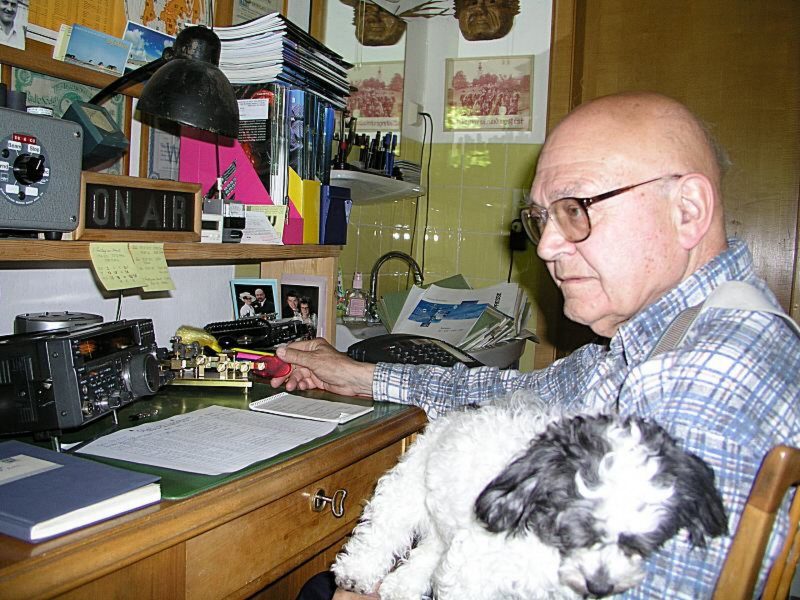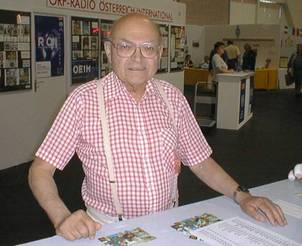 |
Karl H. Hille Lenggries Germany QCWA # 12484 Chapter 106 |
On May 15, 2012, our member Karl-Heinz Hille, DL1VU, celebrates his 90th birthday. At my request, he began to write his personal account, even though, according to his own statement, he was not in good health.
So let'sgo: "I was born on May 15, 1922 in Berlin-Lichtenberg, a working-class district. Two of my uncles were true "radios", Uncle Schorsch still built C's from glass plates and Stanniol, Uncle Hans already built superhets with three-pole tubes and frame antennas. I built my first detector RX 1932, which even worked. So from the heritage of me, I was a hopeless case. Uncle Karl gave me the "Radiobook" by Gunther to read. I was totally infected with that. On top of that, my father could be heard singing songs on the Berliner Rundfunk.In 1932 I joined the Kantschule in Karlshorst, where Dr. Georg Struth, a radio scientist, became my math and physics teacher. I did the Abi in physics with the theme: "The two-way direction", which I had to recite. Note one! In 1938 I joined the DE course in Neukolln, the instructor was Egon Fontane, O1EF, OM Voigt, later DL7AV, was my CW teacher. An intimate friendship until his death connected me with Harry Lilienthal, DL7AH, who became DE-6872 there. I first fell through with three errors in hearing at 60 bpm. Was in the next exam run DE 6909. First QSO in peace still 1939. The DASD standard receiver 7b I had built in the construction community of the district association Southeast in the basement of the BV-Heimwith the help of OM Pixa. The head was OM Hans Rehder, caretaker of the Bordasch family, who led a strict regiment. The TX (with 1x RE 604 (Triode) in Hartley circuit) was mounted on a board made of spruce wood: I had received the 350-pF-Drehko as a gift from OM Freiherr von Turkheim-Geislern, DE-002. The coil was wrapped in 8mm copper pipe, which I had bought on the scrapyard for a large part of my pocket money. It had originally been the gasoline line of a car. The tube RE 604 was able to generate 10 watts of HF, which Harry was very critical of: "Man, Kalle, the Peiler ham you immediately, if you leave with such a QRO!" The standard of the black transmitters at that time was the tube RE 134, which could make about 3 watts. My button was a German post key made of hardwood and brass, which I had obtained from the scrap of the Reichspostzentralamt for 2 Reichsmark. I had my first radio contact with Karl Kallemaa, ES5D. to 14 MHz. This QRG could be badly targeted. The antenna was a 10 m long fox antenna, which was placed on the roof tiles and led over the balcony into the room; Material green with cotton spun coil wire. In the spring of 1939, I was awarded the DE certificate by DR. Otto Laass, the advertising director of Telefunken. (In truth, the good Dr. Laass had no idea that I was already a buffed-out black station.) In 1940 I moved to the Sudetenland, where I became even more active with weekly QSOs with Harry Lilienthal, which we agreed by postcard: "Our cinema is 80 m long!" Harry was always YL2FS, I changed the call every time: I1KN, HA0DL... I had now stretched a 38 m long fox antenna and a 54 m long long wire antenna on the 30 m high factory fireplace. In the late summer of 1949, Harry was revealed by touchclicks in his neighbour's VE 301, arrested and holed up in the police headquarters on Alexanderplatz. ... " Unfortunately, Karl's personal accounts of the first 25 years of his radio experience end here. I will try to compile the important information from a wide range of sources and attach it to his report. From 1941, Karl was in the radio communications of the Wehrmacht, after training as a radio technician he was employed in communications, radio observation, radio tracking, frequency consulting and equipment. He developed a remote sensing of telegraphy transmitters by means of carrier frequency transmission. Already in May 1945 he put his amateur radio station back into operation in order to fulfill his unbroken zeal and drive, the amateur broadcasting activity. Incidentally, it was a time when the US occupying forces had even placed the possession of a transmitter tube under severe criminal penalties. After studying pedagogy, Karl-Heinz Hille began his work as a teacher, later mainly in the science and mathematics subjects at secondary schools, technical colleges and in the telecollege. This was followed by numerous labor-intensive years dedicated to the development and reorganization of the amateur radio service in Germany, among others he was a founding member of the Bavarian Amateur Radio Club, a forerunner of the German Amateur Radio Club (DARC) with activities as a radio operator within the district of Bayern-Sud. In general, he took on the central tasks within the DARC e.V. and was therefore one of the founders of the OV C07 (1967).In 1965 Karl was awarded the Golden Pin of Honour of the DARC, in 2009 he was honoured for 70 years of membership in the DARC. As an active radio amateur, OM Karl-Heinz Hille DL1VU published his very comprehensive knowledge in the form of articles (not only for newcomers interested and worth reading!) in the Club cq-DL in the 60s and 70s and later also published it in book form. The first book "From Electron to Swing Circle" deals with the technical field and, like all other publications, developed into a standard and reference work, which was not to be missed in any Shack. As the author of countless publications, Karl H. Hille still enjoys an outstanding reputation. both nationally and internationally. The topic of antenna technology is of particular importance in his life. His remarks were and are always oriented towards the special requirements of the practice within the amateur radio service and have inspired some OM to successfully recreate - also through his way of writing and to convey the contents to the reader in a structured way. His publications are referred to in the ARRL Antenna Compendium and In Rothammel's Antenna Book. As author of the books "Introduction to Amateur Radio Technology, 1985", "The Dipole in Theory and Practice, 1998", "Windom and Stromsummenantennen, 2000" and co-author of the works "Introduction to Amateur Radio Technology, Part C: CW-Manual" and "Das Antennenlexikon, 1988" he paved the difficult path to amateur radio for many aspiring radio amateurs and, on the other hand, ensured the preservation of well-known, high-quality knowledge and inspired further training within the community of radio amateurs. Even today you can download DL1VU's book "From Electron to Swinging Circle"
Over many years, OM Hille, DL1VU, as speaker of numerous lectures at important events, demonstrated his great commitment and effort to make the diverse insights of his reflections and attempts accessible to a wide audience. He received several patents for the development of his antennas, which were always particularly tailored to the needs of the amateur radio service. (1974 Grant of a British patent for the optimized T-antenna (GB)
